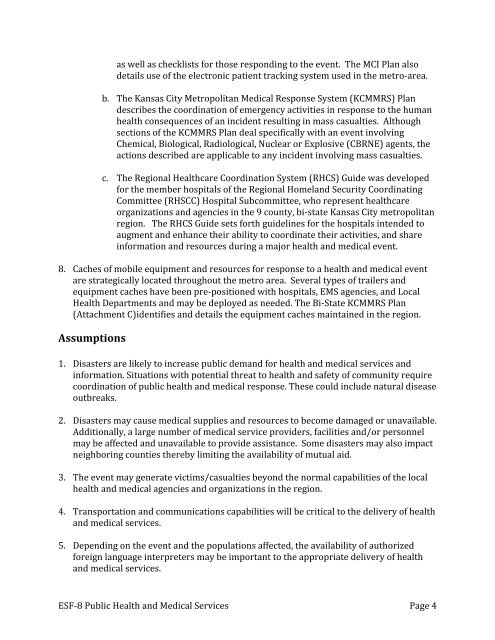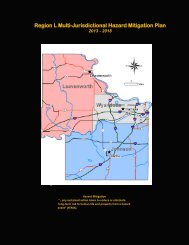ESF-8 Public Health & Medical Services - jocoem
ESF-8 Public Health & Medical Services - jocoem
ESF-8 Public Health & Medical Services - jocoem
Create successful ePaper yourself
Turn your PDF publications into a flip-book with our unique Google optimized e-Paper software.
as well as checklists for those responding to the event. The MCI Plan alsodetails use of the electronic patient tracking system used in the metro‐area.b. The Kansas City Metropolitan <strong>Medical</strong> Response System (KCMMRS) Plandescribes the coordination of emergency activities in response to the humanhealth consequences of an incident resulting in mass casualties. Althoughsections of the KCMMRS Plan deal specifically with an event involvingChemical, Biological, Radiological, Nuclear or Explosive (CBRNE) agents, theactions described are applicable to any incident involving mass casualties.c. The Regional <strong>Health</strong>care Coordination System (RHCS) Guide was developedfor the member hospitals of the Regional Homeland Security CoordinatingCommittee (RHSCC) Hospital Subcommittee, who represent healthcareorganizations and agencies in the 9 county, bi‐state Kansas City metropolitanregion. The RHCS Guide sets forth guidelines for the hospitals intended toaugment and enhance their ability to coordinate their activities, and shareinformation and resources during a major health and medical event.8. Caches of mobile equipment and resources for response to a health and medical eventare strategically located throughout the metro area. Several types of trailers andequipment caches have been pre‐positioned with hospitals, EMS agencies, and Local<strong>Health</strong> Departments and may be deployed as needed. The Bi‐State KCMMRS Plan(Attachment C)identifies and details the equipment caches maintained in the region.Assumptions1. Disasters are likely to increase public demand for health and medical services andinformation. Situations with potential threat to health and safety of community requirecoordination of public health and medical response. These could include natural diseaseoutbreaks.2. Disasters may cause medical supplies and resources to become damaged or unavailable.Additionally, a large number of medical service providers, facilities and/or personnelmay be affected and unavailable to provide assistance. Some disasters may also impactneighboring counties thereby limiting the availability of mutual aid.3. The event may generate victims/casualties beyond the normal capabilities of the localhealth and medical agencies and organizations in the region.4. Transportation and communications capabilities will be critical to the delivery of healthand medical services.5. Depending on the event and the populations affected, the availability of authorizedforeign language interpreters may be important to the appropriate delivery of healthand medical services.<strong>ESF</strong>‐8 <strong>Public</strong> <strong>Health</strong> and <strong>Medical</strong> <strong>Services</strong> Page 4









